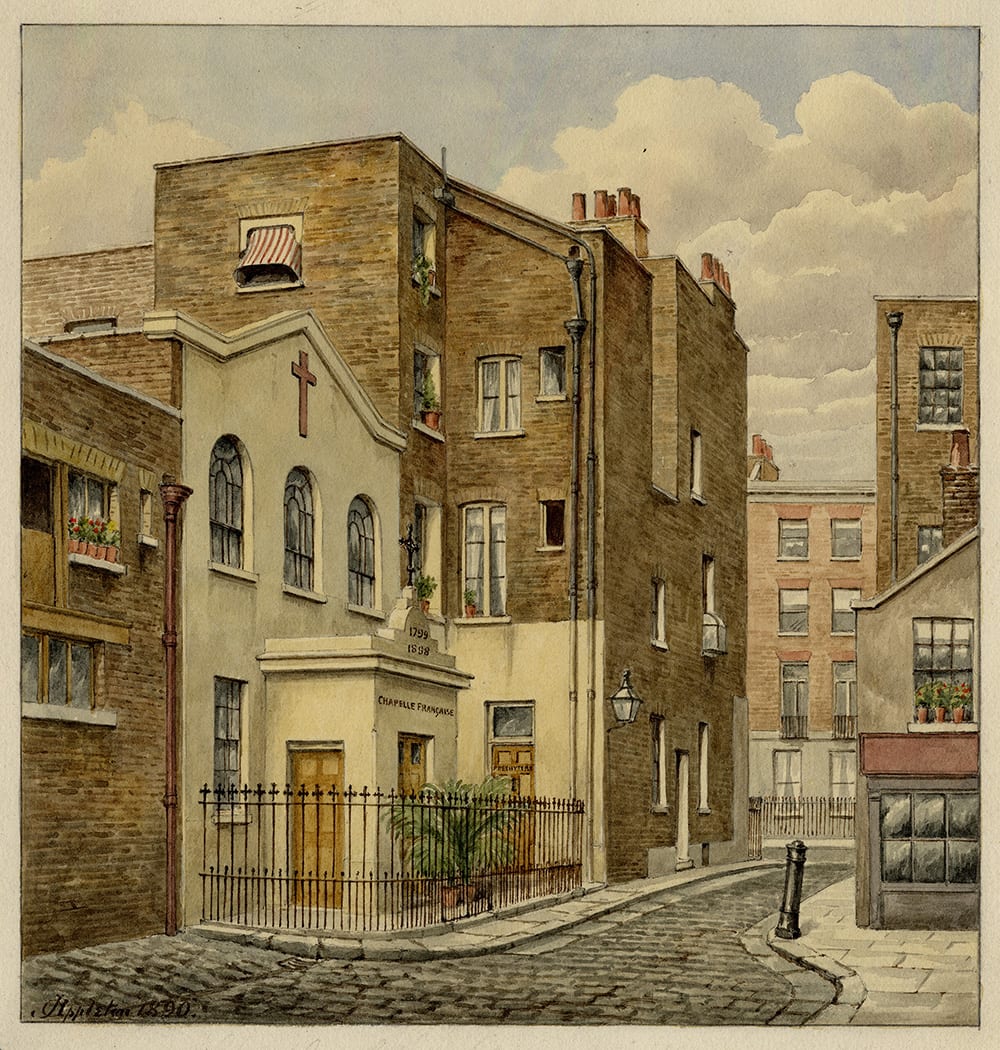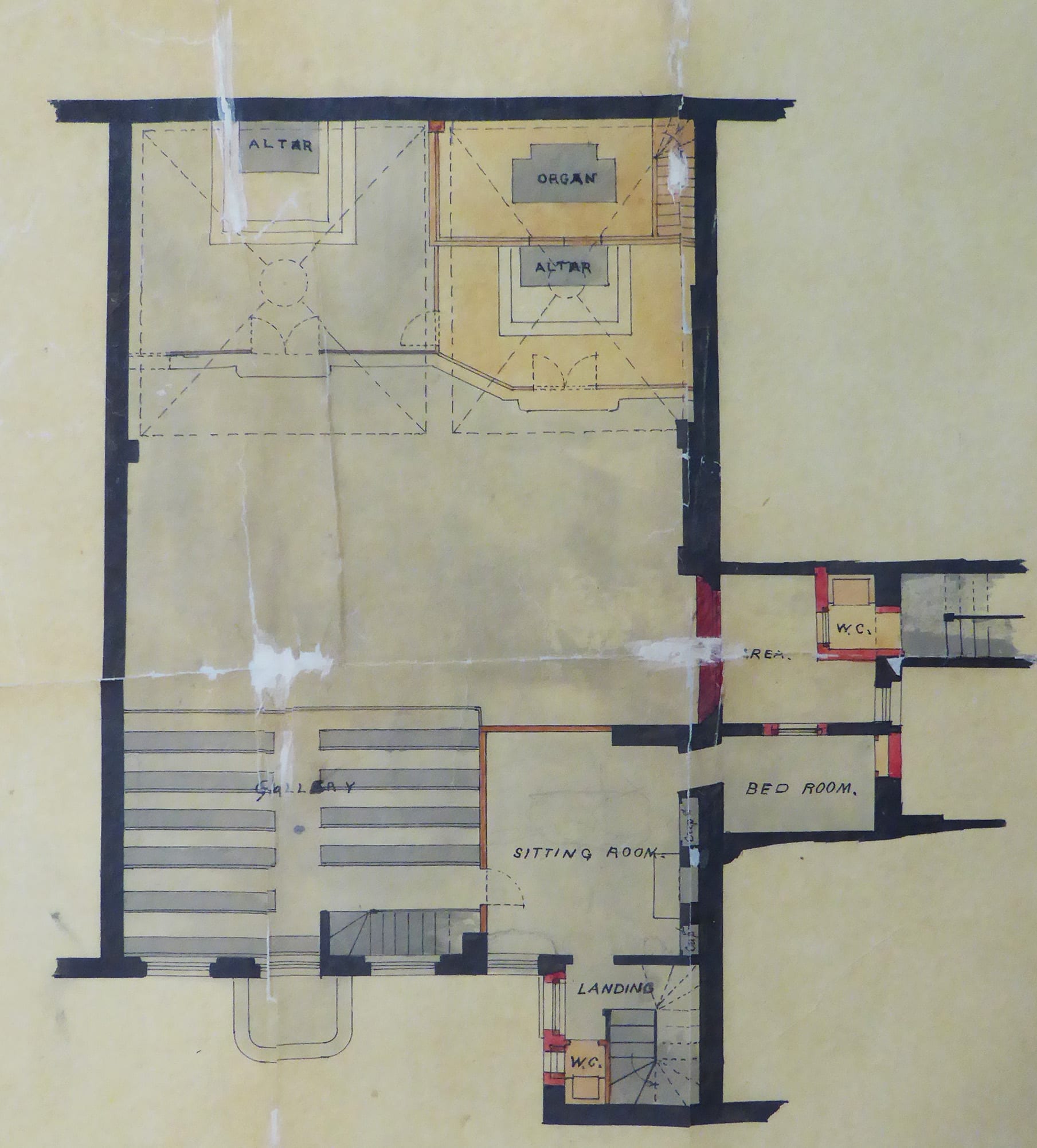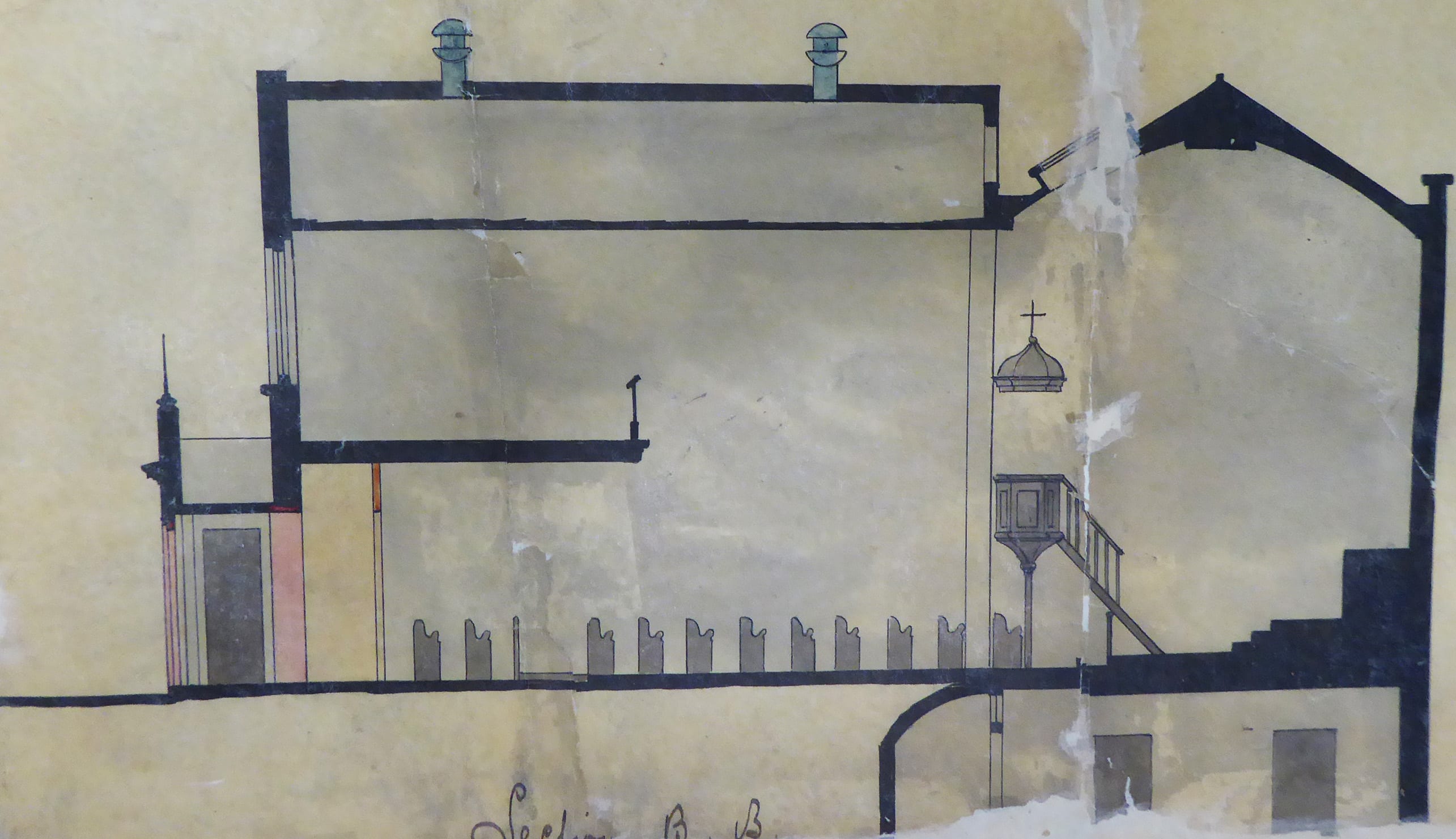The French Chapel in Marylebone
By the Survey of London, on 7 September 2018
A reminder of the once notable French presence in Marylebone is the French definite article in the name. The old name was Marybone, a corruption of Maryborne, referring to the church of St Mary by the bourne built in the early 1400s. Although ‘Mary le Bone’ and variants were in widespread use throughout the eighteenth century, Marybone was still the most common name until the early nineteenth century, when it began to fall out of use, (St) Marylebone subsequently becoming the invariable form. But even today, there are alternative pronunciations, essentially English and French.
There was a French church off the High Street by 1709, perhaps earlier, and from the late seventeenth century French émigrés ran a well-known school near by, patronized by the nobility as a prep school for Westminster and Eton. The French population then was Protestant, part of the Huguenot diaspora particularly associated in London with Spitalfields. But a century after Louis XIV’s revocation of the Edict of Nantes, prompting the main Huguenot exodus, the Revolution brought a new wave of French refugees to Britain, this time Roman Catholic and royalist, many of them priests, many of them aristocrats. A large number settled at least temporarily in the fashionable and still-developing district of south Marylebone, where the executed Louis XVI’s younger brother the Comte d’Artois (from 1824 to 1830 Charles X of France) held court in Baker Street. Consequently, Marylebone became a vital counter-revolutionary centre and it is likely that this association with France helped to bring about the dominance of the French-sounding form of the place name.

The French Chapel in 1890. Watercolour by Thomas G. Appleton. (© Westminster City Archives)
One of thousands to flee to Britain was the Bishop of St Pol-de-Léon, Jean François de La Marche (1729–1806), who landed in Cornwall from a smuggler’s boat in 1792. As the effective leader of the exiled French clergy, working with the Vicar Apostolic of London, Bishop John Douglass, de La Marche was behind the opening of several French chapels including that in Marylebone. There was already a Roman Catholic chapel there, recently opened in association with the Spanish embassy in Manchester Square, the forerunner of present-day St James’s, Spanish Place. But a makeshift French chapel was soon set up in Paddington Street, in a house on the corner of Dorset Mews East (now Kenrick Place), under the charge of the Abbé François Bourret of the Society of Saint-Sulpice.

Extract from the Ordnance Survey 25-inch map, 1875, showing the French Chapel in Little George Street, just south of King Street. (Reproduced with the permission of the National Library of Scotland)
In 1798 the site for a permanent chapel was found on the Portman estate in Little George Street, a now-vanished mews just east of Gloucester Place between King Street (part now of Blandford Street) and George Street. The street was as yet only half built up. Funds for building came from French exiles and English sympathizers, Protestant as well as Catholic, including the Marchioness of Buckingham who had converted to Catholicism in 1788. A substantial grant came from the Montreal branch of the Society of Saint-Sulpice. Much of the physical work was carried out by priests and their compatriots. Dedicated to Our Lady of the Annunciation, the chapel opened on 15 March 1799 with a grand service of consecration attended by French royalty and senior ecclesiastics. Over the following decades, the chapel saw many important services, attended by many of the leading members of the royal houses of Bourbon and Orléans.

Front elevation, 1886, by Henry Petit, architect. (© Portman Estate)
In its original form, the chapel was exceptionally modest, externally plain and comprising a narrow space with a single aisle. In 1815, following the restoration of the monarchy, Louis XVIII formally granted it the status of Chapel Royal and a grant sufficiently large to allow pew-rents to be abolished. This led to the attendance of many poor Catholics, Irish and English as well as French, and the chapel had to be enlarged, resulting in a second aisle, gallery, and additional accommodation. Financial support from France stopped with the revolution of July 1830, but was later reinstated, finally ending under the Third Republic in 1881. Thereafter the chapel depended, as originally, on voluntary subscriptions and became effectively a private chapel. A fund-raising campaign for repairs and a new lease from the Portman Estate was set up under the leadership of Cardinal Manning, who rededicated the chapel to St Louis de France. Improvements to the building in 1886 were overseen by the architect Henry Petit of Welbeck Street (1847–1926), whose Paris-born parents had eventually settled in Marylebone. But when the new lease was obtained it was for only 25 years.

Ground plan, 1886, by Henry Petit, architect. (© Portman Estate)
As described in 1886, the interior of the chapel was ‘scarcely larger than an ordinary drawing room’, with the main altar and ‘a diminutive stand for an American organ’ at the far end, facing the gallery, which was at one time set aside for royalty. There were windows only at the front, and the space was therefore dependent on toplighting. A winding staircase to the side of the gallery gave access to the priests’ living quarters and ancillary rooms.

Upper level plan, 1886, by Henry Petit, architect. (© Portman Estate)
The chapel was to acquire a number of valuable furnishings and artefacts, but perhaps the most remarkable was the original altar painting of the Annunciation, the work of the Roman Catholic artist Maria Cosway, then living at Stratford Place in Oxford Street, with her husband the miniaturist Richard Cosway. This was destroyed in 1858, when velvet hangings over the altar caught light at the funeral of the Countess de Lavradio, wife of the Portuguese Ambassador.

Long section, 1886, by Henry Petit, architect. (© Portman Estate)
By the end of the century, Marylebone was no longer a particular centre of the London French community and the building had largely been superseded by the church of Notre Dame de France in Leicester Place, opened in 1868. Closure followed soon after the death of the long-serving priest, the Very Rev. Louis Toursel or Tersel, in 1910, a final service being held on 12 February 1911. Soon afterwards the seating and other fittings were stripped out. The lease had only a couple of years to run and although there was some negotiation for a new one the unauthorized removal of the fittings caused difficulty and the building was surrendered together with a payment apparently for reinstatement. Later that year the London County Council decided to rename Little George Street after Sydney Carton of A Tale of Two Cities.

Section, 1886, by Henry Petit, architect. (© Portman Estate)
The chapel was used in 1912–14 by Anglicans as their Chapel of the Annunciation, while their church, the former Quebec Chapel on the corner of Bryanston Street and Old Quebec Street, was rebuilt. During the First World War it was used for training women and girls to make toys and gloves, items which until the war had been imported from Germany and Austria. Later it was used as a furniture warehouse, as an undertaker’s chapel and as a public hall, called Carton Hall. From 1946 until the completion of a new synagogue in Crawford Place in 1957 it was occupied as the Western Synagogue, housing a congregation bombed out of their old West End building. In 1958 it was acquired by Angus McKenzie, who employed the cinema architect Leslie C. Norton to turn it into the original Olympic Sound Studios. Recordings made there included Millie Small’s ‘My Boy Lollipop’ in 1964. By that time redevelopment schemes for the whole block were being pursued. The building was demolished in 1969 and Carton Street itself ceased to exist.

Maria Cosway’s altarpiece painting. Mezzotint of 1800 by Valentine Green. (© Trustees of the British Museum)
3 Responses to “The French Chapel in Marylebone”
- 1
-
2
Sarah wrote on 28 June 2019:
I wish it was still there I have family history there, such a shame, I would love to have visited it.
-
3
philip mansel wrote on 14 January 2021:
excellent. thankyou. memorial services were held there for the Duc d’Enghien in 1804 and the Abbe Edgeworth in 1807, and many bishops. the funeral of the last ‘Queen of France’, Marie Josephine de Savoie was held there in November 1810, and the first communion of the Comte de Paris, grandson of Louis-Philippe, who attended the service (his last appearance in public), in 1850. I think some Bonapartes attended in the 1830’s. see the books by Kirsty Carpenter and edited by Debra Kelly on the French in London.
 Close
Close



Thank you. I’ve been looking for a history of that building.